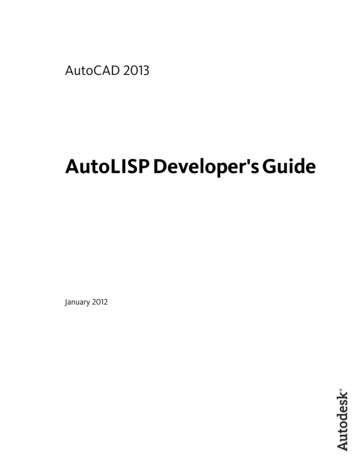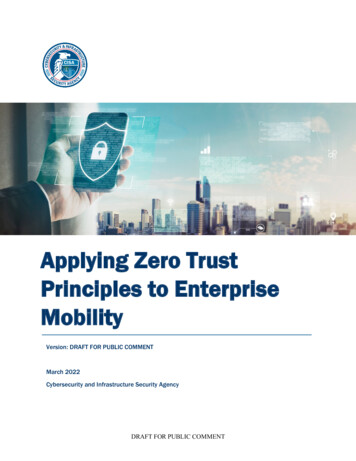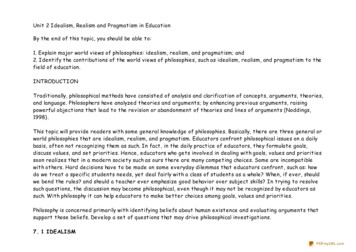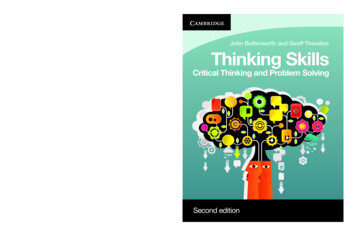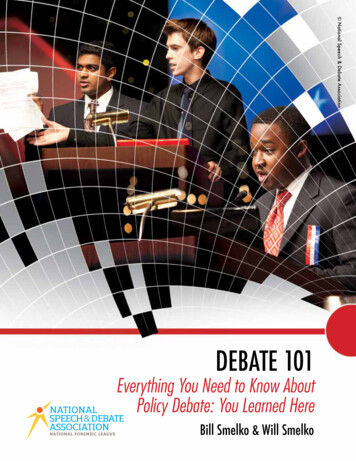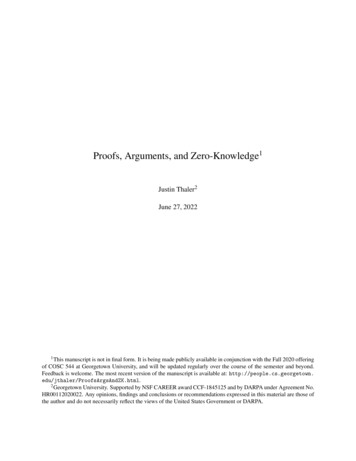
Transcription
Proofs, Arguments, and Zero-Knowledge1Justin Thaler2June 27, 20221 Thismanuscript is not in final form. It is being made publicly available in conjunction with the Fall 2020 offeringof COSC 544 at Georgetown University, and will be updated regularly over the course of the semester and beyond.Feedback is welcome. The most recent version of the manuscript is available at: AndZK.html.2 Georgetown University. Supported by NSF CAREER award CCF-1845125 and by DARPA under Agreement No.HR00112020022. Any opinions, findings and conclusions or recommendations expressed in this material are those ofthe author and do not necessarily reflect the views of the United States Government or DARPA.
AbstractInteractive proofs (IPs) and arguments are cryptographic protocols that enable an untrusted prover to providea guarantee that it performed a requested computation correctly. Introduced in the 1980s, IPs and argumentsrepresented a major conceptual expansion of what constitutes a “proof” that a statement is true.Traditionally, a proof is a static object that can be easily checked step-by-step for correctness. In contrast,IPs allow for interaction between prover and verifier, as well as a tiny but nonzero probability that an invalidproof passes verification. Arguments (but not IPs) even permit there to be “proofs” of false statements, solong as those “proofs” require exorbitant computational power to find. To an extent, these notions mimicin-person interactions that mathematicians use to convince each other that a claim is true, without goingthrough the painstaking process of writing out and checking a traditional static proof.Celebrated theoretical results from the 1980s and 1990s such as IP PSPACE and MIP NEXPshowed that, in principle, surprisingly complicated statements can be verified efficiently. What is more, anyargument can in principle be transformed into one that is zero-knowledge, which means that proofs revealno information other than their own validity. Zero-knowledge arguments have a myriad of applications incryptography.Within the last decade, general-purpose zero-knowledge arguments have made the jump from theoryto practice. This has opened new doors in the design of cryptographic systems, and generated additionalinsights into the power of IPs and arguments (zero-knowledge or otherwise). There are now no fewer thanfive promising approaches to designing efficient, general-purpose zero-knowledge arguments. This surveycovers these approaches in a unified manner, emphasizing commonalities between them.1
Preface and AcknowledgementsThis manuscript began as a set of lecture notes accompanying the Fourteenth Bellairs’ Crypto-Workshopin 2015. I am indebted to Claude Crépeau and Gilles Brassard for their warm hospitality in organizingthe workshop, and to all of the workshop participants for their generosity, patience, and enthusiasm. Thenotes were further expanded during the Fall 2017 offering of COSC 544 at Georgetown University, andbenefited from comments provided by students in the course. The knowledge and feedback of a numberof people heavily influenced the development of this manuscript, including Sebastian Angel, Srinath Setty,abhi shelat, Michael Walfish, and Riad Wahby. I owe a special thanks to Riad for his patient explanations ofmany cryptographic tools covered in this survey, and his willingness to journey to the end of any rabbit holehe encounters. There are many fewer errors in this manuscript because of Riad’s help; any that remain areentirely my own.A major benefit of taking 5 years (and counting) to complete this manuscript is the many excitingdevelopments that can now be included. This survey would have looked very different had it been completedin 2015, or even in 2018 (perhaps 1/3 of the content covered did not exist 5 years ago). During this period,the various approaches to the design of zero-knowledge arguments, and the relationships between them,have come into finer focus. Yet owing to the sheer volume of research papers, it is increasingly challengingfor those first entering the area to extract a clear picture from the literature itself.Will the next 5-10 years bring a similar flood of developments? Will this be enough to render generalpurpose arguments efficient enough for routine deployment in diverse cryptographic systems? It is my hopethat this survey will make this exciting and beautiful area slightly more accessible, and thereby play somerole in ensuring that the answer to both questions is “yes.”Washington D.C., August 20202
Contents1Introduction61.1 Mathematical Proofs . . . . . . . . . . . . . . . . . . . . . . . . . . . . . . . . . . . . . . 101.2 What kinds of non-traditional proofs will we study? . . . . . . . . . . . . . . . . . . . . . . 102The Power of Randomness: Fingerprinting and Freivalds’ Algorithm2.1 Reed-Solomon Fingerprinting . . . . . . . . . . . . . . . . . . . .2.2 Freivalds’ Algorithm . . . . . . . . . . . . . . . . . . . . . . . . .2.3 An Alternative View of Fingerprinting and Freivalds’ Algorithm . .2.4 Univariate Lagrange Interpolation . . . . . . . . . . . . . . . . . .1313161718Definitions and Technical Preliminaries3.1 Interactive Proofs . . . . . . . . . . . . . . . . . . . .3.2 Argument Systems . . . . . . . . . . . . . . . . . . .3.3 Robustness of Definitions and the Power of Interaction3.4 Schwartz-Zippel Lemma . . . . . . . . . . . . . . . .3.5 Low Degree and Multilinear Extensions . . . . . . . .3.6 Exercises . . . . . . . . . . . . . . . . . . . . . . . .23232425282832345.Interactive Proofs4.1 The Sum-Check Protocol . . . . . . . . . . . . . . . . . . . . . . .4.2 First Application of Sum-Check: #SAT IP . . . . . . . . . . . . .4.3 Second Application: A Simple IP for Counting Triangles in Graphs4.4 Third Application: Super-Efficient IP for M AT M ULT . . . . . . . .4.5 Applications of the Super-Efficient M AT M ULT IP . . . . . . . . . .4.6 The GKR Protocol and Its Efficient Implementation . . . . . . . . .4.7 Exercises . . . . . . . . . . . . . . . . . . . . . . . . . . . . . . .3434404346515872Publicly Verifiable, Non-interactive Arguments via Fiat-Shamir5.1 The Random Oracle Model . . . . . . . . . . . . . . . . . . . . . . . . . .5.2 The Fiat-Shamir Transformation . . . . . . . . . . . . . . . . . . . . . . .5.3 Fiat-Shamir Preserves Knowledge Soundness in the Random Oracle Model5.4 Fiat-Shamir in the Plain Model . . . . . . . . . . . . . . . . . . . . . . . .5.5 Exercises . . . . . . . . . . . . . . . . . . . . . . . . . . . . . . . . . . .7575768181823.
6789Front Ends: Turning Computer Programs Into Circuits6.1 Introduction . . . . . . . . . . . . . . . . . . . . . . . . . . . .6.2 Machine Code . . . . . . . . . . . . . . . . . . . . . . . . . . .6.3 A First Technique For Turning Programs Into Circuits [Sketch] .6.4 Turning Small-Space Programs Into Shallow Circuits . . . . . .6.5 Turning Computer Programs Into Circuit Satisfiability Instances6.6 Alternative Transformations and Optimizations . . . . . . . . .6.7 Exercises . . . . . . . . . . . . . . . . . . . . . . . . . . . . .84848586878896104A First Succinct Argument for Circuit Satisfiability, from Interactive Proofs7.1 A Naive Approach: An IP for Circuit Satisfiability . . . . . . . . . . . . .7.2 Succinct Arguments for Circuit Satisfiability . . . . . . . . . . . . . . . . .7.3 A First Succinct Argument for Circuit Satisfiability . . . . . . . . . . . . .7.4 Knowledge Soundness . . . . . . . . . . . . . . . . . . . . . . . . . . . .105106106107112MIPs and Succinct Arguments8.1 MIPs: Definitions and Basic Results . . .8.2 An Efficient MIP For Circuit Satisfiability8.3 A Succinct Argument for Deep Circuits .8.4 Extension from Circuit-SAT to R1CS-SAT8.5 MIP NEXP . . . . . . . . . . . . . . .116116119125126131PCPs and Succinct Arguments9.1 PCPs: Definitions and Relationship to MIPs . . . . . . . . . . .9.2 Compiling a PCP Into a Succinct Argument . . . . . . . . . . .9.3 A First Polynomial Length PCP, From an MIP . . . . . . . . . .9.4 A PCP of Quasilinear Length for Arithmetic Circuit Satisfiability.132132133136138.10 Interactive Oracle Proofs10.1 IOPs: Definition and Associated Succinct Arguments10.2 Polynomial IOPs and Associated Succinct Arguments10.3 A Polynomial IOP for R1CS-satisfiability . . . . . .10.4 FRI and Associated Polynomial Commitments . . . .10.5 Ligero and Brakedown Polynomial Commitments . .10.6 Unifying IPs, MIPs, and IOPs via Polynomial IOPs .14414414514615216016511 Zero-Knowledge Proofs and Arguments11.1 What is Zero-Knowledge? . . . . . . . . . . . . . . . . .11.2 The Limits of Statistical Zero Knowledge Proofs . . . . .11.3 Honest-Verifier SZK Protocol for Graph Non-Isomorphism11.4 Honest-Verifier SZK Protocol for the Collision Problem . .167167170171172.12 Σ-Protocols and Commitments from Hardness of Discrete Logarithm17512.1 Cryptographic Background . . . . . . . . . . . . . . . . . . . . . . . . . . . . . . . . . . . 17512.2 Schnorr’s Σ-Protocol for Knowledge of Discrete Logarithms . . . . . . . . . . . . . . . . . 17712.3 A Homomorphic Commitment Scheme . . . . . . . . . . . . . . . . . . . . . . . . . . . . 1834
13 Zero-Knowledge via Commit-And-Prove and Masking Polynomials13.1 Proof Length of Witness Size Plus Multiplicative Complexity . . . . . . . . . . . . .13.2 Avoiding Linear Dependence on Multiplicative Complexity: zk-Arguments from IPs13.3 Zero-Knowledge via Masking Polynomials . . . . . . . . . . . . . . . . . . . . . .13.4 Discussion and Comparison . . . . . . . . . . . . . . . . . . . . . . . . . . . . . .19219319519720114 Polynomial Commitments from Hardness of Discrete Logarithm14.1 A Zero-Knowledge Scheme with Linear Size Commitments .14.2 Constant Size Commitments But Linear Size Evaluation Proofs14.3 Trading Off Commitment Size and Verification Costs . . . . .14.4 Bulletproofs . . . . . . . . . . . . . . . . . . . . . . . . . . .20320620621021115 Polynomial Commitments from Pairings15.1 Cryptographic Background . . . . . . . . . . . . . . . . . . . . . . . . . . . .15.2 KZG: Univariate Polynomial Commitments from Pairings and a Trusted Setup .15.3 Extension of KZG to Multilinear Polynomials . . . . . . . . . . . . . . . . . .15.4 Dory: Transparent Scheme with Logarithmic Verification Costs . . . . . . . . .223223226231232.16 Wrap-Up of Polynomial Commitments16.1 Batch Evaluation of Homomorphically Committed Polynomials16.2 Commitment Scheme for Sparse Polynomials . . . . . . . . . .16.3 Polynomial Commitment Schemes: Pros and Cons . . . . . . .16.4 Additional Approaches . . . . . . . . . . . . . . . . . . . . . .24724724725025117 Linear PCPs and Succinct Arguments17.1 Overview: Interactive Arguments From “Long”, Structured PCPs .17.2 Committing to a Linear PCP without Materializing It . . . . . . .17.3 A First Linear PCP for Arithmetic Circuit Satisfiability . . . . . .17.4 GGPR: A Linear PCP Of Size O( F S ) for Circuit-SAT and R1CS17.5 Non-Interactivity and Public Verifiability . . . . . . . . . . . . . .25325325525726026318 SNARK Composition and Recursion18.1 Composing Two Different SNARKs . . . . . . . . . . . . . . . . .18.2 Deeper Compositions of SNARKs . . . . . . . . . . . . . . . . . .18.3 Other Applications of SNARK Composition . . . . . . . . . . . . .18.4 SNARKs for Iterative Computation via Recursion . . . . . . . . . .18.5 SNARKs for Iterative Computation via Homomorphic Commitments.27127127227527627919 Bird’s Eye View of Practical Arguments28819.1 A Taxonomy of SNARKs . . . . . . . . . . . . . . . . . . . . . . . . . . . . . . . . . . . . 28919.2 Pros and Cons of the Approaches . . . . . . . . . . . . . . . . . . . . . . . . . . . . . . . . 29119.3 Other Issues Affecting Concrete Efficiency . . . . . . . . . . . . . . . . . . . . . . . . . . 2945
Chapter 1IntroductionThis manuscript is about verifiable computing (VC). VC refers to cryptographic protocols called interactiveproofs (IPs) and arguments that enable a prover to provide a guarantee to a verifier that the prover performeda requested computation correctly. Introduced in the 1980s, IPs and arguments represented a major conceptual expansion of what constitutes a “proof” that a statement is true. Traditionally, a proof is a static objectthat can be easily checked step-by-step for correctness, because each individual step of the proof shouldbe trivial to verify. In contrast, IPs allow for interaction between prover and verifier, as well as a tiny butnonzero probability that an invalid proof passes verification. The difference between IPs and argumentsis that arguments (but not IPs) permit the existence of “proofs” of incorrect statements, so long as those“proofs” require exorbitant computational power to find.1Celebrated theoretical results from the mid-1980s and early 1990s indicated that VC protocols can, atleast in principle, accomplish amazing feats. These include enabling a cell phone to monitor the executionof a powerful but untrusted (even malicious) supercomputer, enabling computationally weak peripheraldevices (e.g., security card readers) to offload security-critical work to powerful remote servers, or letting amathematician obtain a high degree of confidence that a theorem is true by looking at only a few symbolsof a purported proof.2VC protocols can be especially useful in cryptographic contexts when they possess a property calledzero-knowledge. This means that the proof or argument reveals nothing but its own validity.To give a concrete sense of why zero-knowledge protocols are useful, consider the following quintessential example from authentication. Suppose that Alice chooses a random password x and publishes a hashz h(x), where h is a one-way function. This means that given z h(x) for a randomly chosen x, enormouscomputational power should be required to find a preimage of z under h, i.e., an x0 such that h(x0 ) z. Later,suppose that Alice wants to convince Bob that she is the same person who published z. She can do thisby proving to Bob that she knows an x0 such that h(x0 ) z. This will convince Bob that Alice is the sameperson who published z, since it means that either Alice knew x to begin with, or she inverted h (which isassumed to be beyond the computational capabilities of Alice).How can Alice convince Bob that she knows a preimage of z under h? A trivial proof is for Alice tosend x to Bob, and Bob can easily check that h(x) z. But this reveals much more information than thatAlice knows a preimage of z. In particular it reveals the preimage itself. Bob can use this knowledge to1 Forexample, an argument, but not an IP, might make use of a cryptosystem, such that it is possible for a cheating prover tofind a convincing “proof” of a false statement if (and only if) the prover can break the cryptosystem.2 So long as the proof is written in a specific, mildly redundant format. See our treatment of probabilistically checkable proofs(PCPs) in Chapter 9.6
impersonate Alice forevermore, since now he too knows the preimage of z.In order to prevent Bob from learning information that can compromise the password x, it is importantthat the proof reveals nothing beyond its own validity. This is exactly what the zero-knowledge propertyguarantees.A particular goal of this survey is to describe a variety of approaches to constructing so-called zeroknowledge Succinct Non-interactive Arguments of Knowledge, or zk-SNARKs for short. “Succinct” meansthat the proofs are short. “Non-interactive” means that the proof is static, consisting of a single messagefrom the prover. “Of Knowledge” roughly means that the protocol establishes not only that a statementis true, but also that the prover knows a “witness” to the veracity of the statement.3 Argument systemssatisfying all of these properties have a myriad of applications throughout cryptography.Practical zero-knowledge protocols for highly specialized statements of cryptographic relevance (suchas proving knowledge of a discrete logarithm [Sch89]) have been known for decades. However, generalpurpose zero-knowledge protocols have only recently become plausibly efficient enough for cryptographicdeployment. By general-purpose, we mean protocol design techniques that apply to arbitrary computations.This exciting progress has involved the introduction of beautiful new protocols, and brought a surge ofinterest in zero-knowledge proofs and arguments. This survey seeks to make accessible, in a unified manner,the main ideas and approaches to the design of these protocols.Background and context. In the mid-1980s and 1990s, theoretical computer scientists showed that IPsand arguments can be vastly more efficient (at least, in an asymptotic sense) than traditional NP proofs,4which are static and information-theoretically secure.5 The foundational results characterizing the powerof these protocols (such as IP PSPACE [LFKN92, Sha92], MIP NEXP [BFL91], and the PCP theorem[ALM 98, AS98]) are some of the most influential and celebrated in computational complexity theory.6Despite their remarkable asymptotic efficiency, general-purpose VC protocols were long consideredwildly impractical, and with good reason: naive implementations of the theory would have had comicallyhigh concrete costs (trillions of years for the prover, even for very short computations). But the last decadehas seen major improvements in the costs of VC protocols, with a corresponding jump from theory to practice. Even though implementations of general-purpose VC protocols remain somewhat costly (especiallyfor the prover), paying this cost can often be justified if the VC protocol is zero-knowledge, since zeroknowledge protocols enable applications that may be totally impossible without them. Moreover, emergingapplications to public blockchains have elevated the importance of proving relatively simple statements, onwhich it is feasible to run modern VC protocols despite their costs.Approaches to zero-knowledge protocol design, and philosophy of this survey. Argument systems aretypically developed in a two-step process. First, an information-theoretically secure protocol, such as anIP, multi-prover interactive proof (MIP), or probabilistically checkable proof (PCP), is developed for amodel involving one or more provers that are assumed to behave in some restricted manner (e.g., in an MIP,the provers are assumed not to send information to each other about the challenges they receive from theverifier). Second, the information-theoretically secure protocol is combined with cryptography to “force”3 Forexample, the authentication scenario above really requires a zero-knowledge proof of knowledge for the statement “thereexists a password x such that h(x) z”. This is because the application requires that Bob be convinced not just of the fact that thereexists a preimage x of z under h (which will always be true if h is a surjective function), but also that Alice knows x.4 We formally define notions such as NP and IP in Section 3.3.5 The term information-theoretically secure here refers to the fact that NP proofs (like IPs, but unlike arguments) are secureagainst computationally unbounded provers.6 The results IP PSPACE and MIP NEXP are both covered in this survey (see Sections 4.5.5 and 8.5 respectively).7
a (single) prover to behave in the restricted manner, thereby yielding an argument system. This secondstep also often endows the resulting argument system with important properties, such as zero-knowledge,succinctness, and non-interactivity. If the resulting argument satisfies all of these properties, then it is in facta zk-SNARK.By now, there are a variety promising approaches to developing efficient zk-SNARKs, which can becategorized by the type of information-theoretically secure protocol upon which they are based. Theseinclude (1) IPs, (2) MIPs, (3) PCPs, or more precisely a related notion called interactive oracle proofs(IOPs), which is a hybrid between an IP and a PCP, and (4) linear PCPs. Sections 1.2.1-1.2.3 below give amore detailed overview of these models. This survey explains in a unified manner how to design efficientprotocols in all four information-theoretically secure models, emphasizing commonalities between them.IPs, MIPs, and PCPs/IOPs can all be transformed into succinct interactive arguments by combining themwith a cryptographic primitive called a polynomial commitment scheme; the interactive arguments can thenbe rendered non-interactive and publicly verifiable by applying a cryptographic technique called the FiatShamir transformation (Section 5.2), yielding a SNARK. Transformations from linear PCPs to argumentsare somewhat different, though closely related to certain polynomial commitment schemes. As with theinformation-theoretically secure protocols themselves, this survey covers these cryptographic transformations in a unified manner.Because of the two-step nature of zk-SNARK constructions, it is often helpful to first understand proofsand arguments without worrying about zero-knowledge, and then at the very end understand how to achievezero-knowledge as an “add on” property. Accordingly, we do not discuss zero-knowledge until relativelylate in this survey (Chapter 11). Earlier chapters are devoted to describing efficient protocols in each of theinformation-theoretically secure models, and explaining how to transform them into succinct arguments.By now, zk-SNARKs have been deployed in a number of real-world systems, and there is a large anddiverse community of researchers, industry professionals, and open source software developers working toimprove and deploy the technology. This survey assumes very little formal mathematical background—mainly comfort with modular arithmetic, some notions from the theory of finite fields and groups, andbasic probability theory—and is intended as a resource for anyone interested in verifiable computing andzero-knowledge. However, it does require significant mathematical maturity and considerable comfort withtheorems and proofs. Also helpful (but not strictly necessary) is knowledge of standard complexity classeslike P and NP, and complexity-theoretic notions such as NP-completeness.Chapter-by-chapter outline. The remainder of this introductory section provides more detail on the kindsof protocols studied in this survey. Chapter 2 familiarizes the reader with randomness and the power ofprobabilistic proof systems, through two easy but important case studies. Chapter 3 introduces technicalnotions that will be useful throughout the survey. Chapters 4 describes state-of-the-art interactive proofs.Chapter 5 describes the Fiat-Shamir transformation, a key technique that is used to remove interactionfrom cryptographic protocols. Chapter 7 introduces the notion of a polynomial commitment scheme, andcombines it with the IPs of Chapter 4 and the Fiat-Shamir transformation of Chapter 5 to obtain the firstSNARK covered in the survey. Chapter 8 describes state-of-the-art MIPs and SNARKs derived thereof.Chapters 9-10 describe PCPs and IOPs, and SNARKs derived thereof.Chapter 6 is a standalone chapter describing techniques for representing computer programs in formatsamenable to application of such SNARKs.Chapter 11 introduces the notion of zero-knowledge. Chapter 12 describes a particularly simple type ofzero-knowledge argument called Σ-protocols, and uses them to derive commitment schemes. These commitment schemes serve as important building blocks for more complicated protocols covered in subsequentchapters. Chapter 13 describes efficient techniques for transforming non-zero-knowledge protocols into8
zero-knowledge ones. Chapters 14-16 cover practical polynomial commitment schemes, which can be usedto turn any IP, MIP, or IOP into a succinct zero-knowledge argument of knowledge (zkSNARK). Chapter 17covers our final approach to designing zkSNARKs, namely through linear PCPs. Chapter 18 describes howto recursively compose SNARKs to improve their costs and achieve important primitives such as so-calledincrementally verifiable computation. Finally, Chapter 19 provides a taxonomy of design paradigms forpractical zkSNARKs, and delineates the pros and cons of each approach.Suggestions for reading the manuscript. The manuscript may happily be read from start to finish, butnon-linear paths may offer a faster route to a big-picture understanding of SNARK design techniques. Suggestions to this effect are as follows.Chapters 2 and 3 introduce basic technical notions used throughout all subsequent chapters (finite fields,IPs, arguments, low-degree extensions, the Schwartz-Zippel lemma, etc.), and should not be skipped byreaders unfamiliar with these concepts.Readers may next wish to read the final chapter, Chapter 19, which provides a birds-eye view of allSNARK design approaches and how they relate to each other. Chapter 19 uses some terminology that maybe unfamiliar to the reader at this point, but it should nonetheless be understandable and it provides contextthat is helpful to have in mind when working through more technical chapters.After that, there are many possible paths through the manuscript. Readers specifically interested in theSNARKs that were the first to be deployed in commercial settings can turn to Chapter 17 on linear PCPs.This chapter is essentially self-contained but for its use of pairing-based cryptography that is introducedin Section 15.1 (and, at the very end, its treatment of zero-knowledge, a concept introduced formally inChapter 11).Otherwise, readers should turn to understanding the alternative approach to SNARK design, namely tocombine a polynomial IOP (of which IPs, MIPs, and PCPs are special cases) with a polynomial commitmentscheme.To quickly understand polynomial IOPs, we suggest a careful reading of Section 4.1 on the sum-checkprotocol, followed by Section 4.6 on the GKR interactive proof protocol for circuit evaluation, or Section8.2 giving a 2-prover MIP for circuit satisfiability. Next, the reader can turn to Chapter 7, which explainshow to combine such protocols with polynomial commitments to obtain succinct arguments.To understand polynomial commitment schemes, the reader can either tackle Sections 10.4 and 10.5 tounderstand IOP-based polynomial commitments, or instead turn to Chapters 12 and 14-16 (in that order) tounderstand polynomial commitments based on the discrete logarithm problem and pairings.A compressed overview of polynomial IOPs and polynomial commitments is provided in a sequence ofthree talk videos posted on this manuscript’s webpage7 . Readers may find it useful to watch these videosprior to a detailed reading of Chapters 4-10.Material that can be skipped on a first reading. Sections 4.2-4.5 are devoted to detailed example applications of the sum-check protocol and explaining how to efficiently implement the prover within it. Whilethese sections contain interesting results and are useful for familiarizing oneself with the sum-check protocol, subsequent chapters do not depend on them. Similarly, Chapter 5 on the Fiat-Shamir transformation andChapter 6 on front-ends are optional on a first reading. Sections 9.3 and 9.4 provide PCPs that are mainly ofhistorical interest and can be skipped.Chapters 11 and 13 offer treatments of zero-knowledge that largely stand on their own. Similarly,Chapter 18 discusses SNARK composition and stands on its own.7 sAndZK.html9
1.1Mathematical ProofsThis survey covers different notions of mathematical proofs and their applications in computer science andcryptography. Informally, what we mean by a proof is anything that convinces someone that a statement istrue, and a “proof system” is any procedure that decides what is and is not a convincing proof. That is, aproof system is specified by a verification procedure that takes as input any statement and a claimed “proof”that the statement is true, and decides whether or not the proof is valid.What properties do we want in a proof system? Here are four obvious ones. Any true statement should have a convincing proof of its validity. This property is typically referredto as completeness. No false statement should have a convincing proof. This property is referred to as soundness. Ideally, the verification procedure will be “efficient”. Roughly, this means that simple statementsshould have short (convincing) proofs that can be checked quickly. Ideally, proving should be efficient too. Roughly, this means that simple statements should have short(convincing) proofs that can be found quickly.Traditionally, a mathematical proof is something that can be written and checked line-by-line for correctness. This traditional notion of proof is precisely the one captured by the complexity class NP. However,over the last 30 years, computer scientists have studied much more ge
Zero-knowledge arguments have a myriad of applications in cryptography. Within the last decade, general-purpose zero-knowledge arguments have made the jump from theory to practice. This has opened new doors in the design of cryptographic systems, and generated additional insights into the power of IPs and arguments (zero-knowledge or otherwise).

